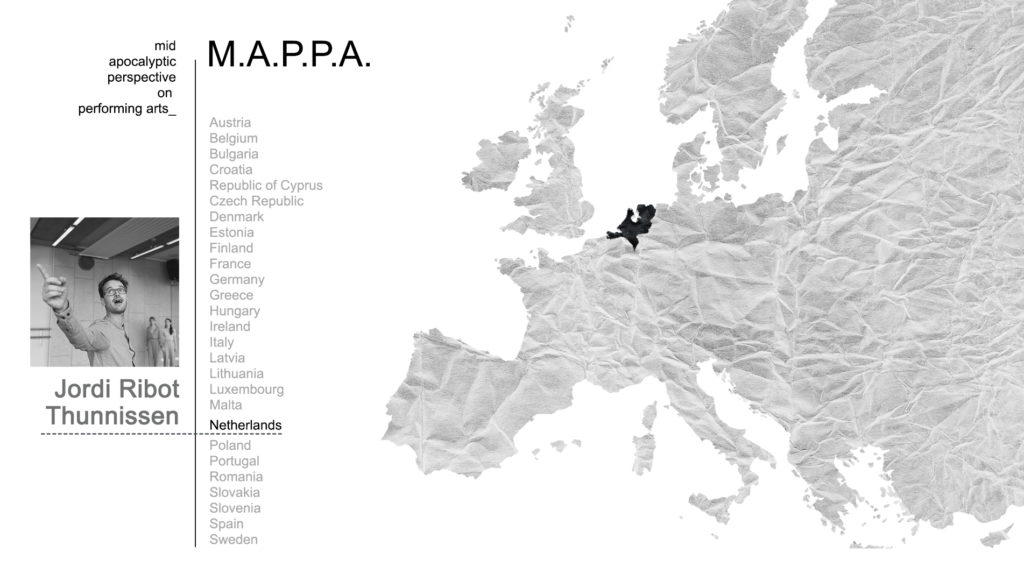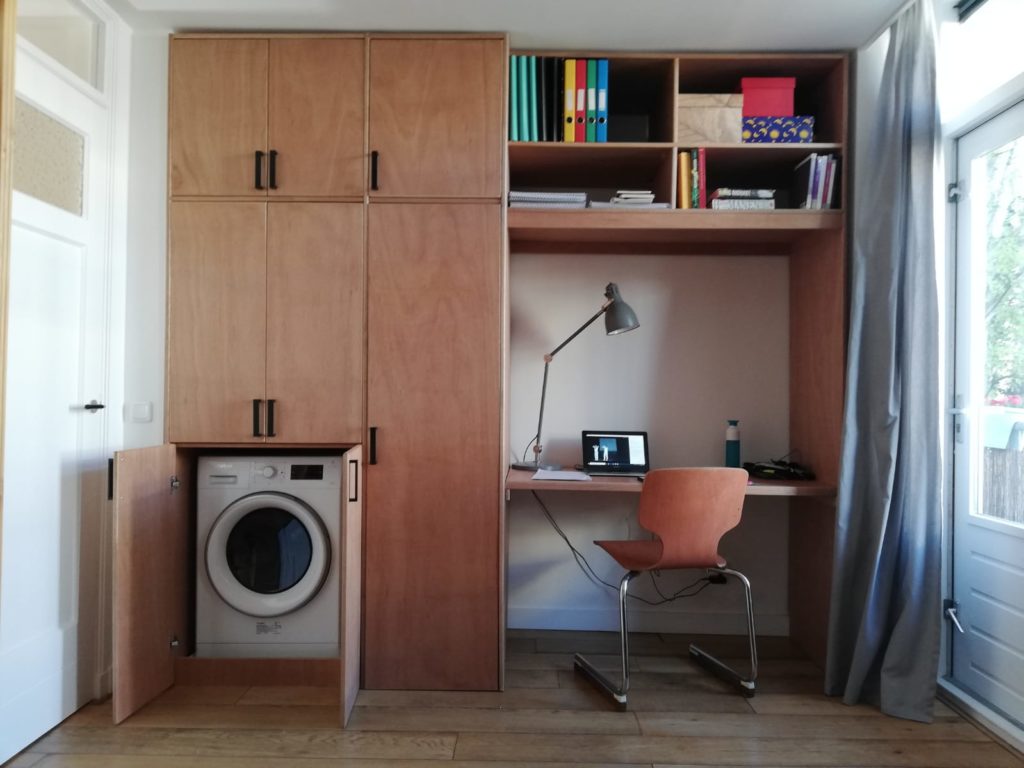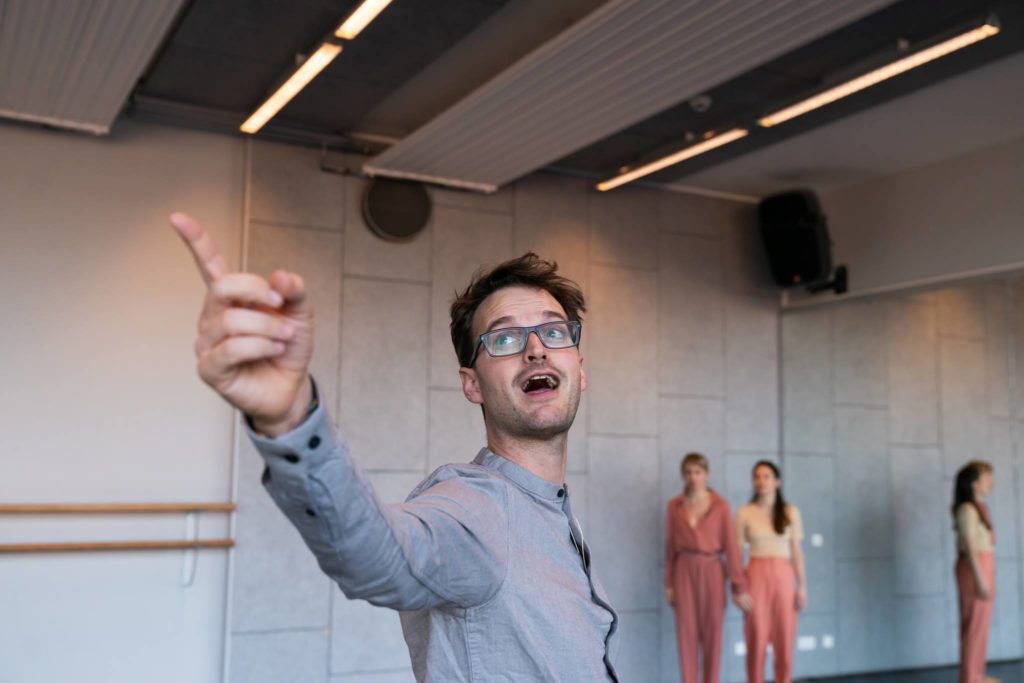
M.A.P.P.A. è un progetto di ricognizione e mappatura internazionale sulla critica dedicata alle performing arts. Abbiamo intervistato giovani giornalisti, osservatori e critici provenienti da tutta Europa.
Leggi altre interviste del progetto M.A.P.P.A.
Jordi Ribot Thunnissen è un performer, coreografo, dance dramaturg, docente e critico indipendente. Cresciuto a Barcellona, oggi vive ad Amsterdam, dove insegna storia della danza presso ArtEz, importante centro universitario per la formazione artistica.
Quali misure sono state prese a sostegno dei lavoratori dello spettacolo in Olanda?
Prima di parlare delle misure specifiche adottate dal governo olandese, penso che sia importante inquadrarle in un dibattito più ampio, iniziato nel 2010 quando il Primo Ministro Mark Rutte (VVD, Liberali) è salito al potere grazie a una coalizione che ha accettato il tacito sostegno del partito di estrema destra PVV di Geert Wilders. Wilders, esperto nel plasmare il dibattito pubblico con sparate ideologiche senza un controllo dei fatti, ha reso chiara la sua opinione sul mondo dell’arte già nel 2007, quando ha descritto tutte le attività culturali come “hobby di sinistra”. In quel primo governo Rutte, è stato incaricato di ristrutturare le finanze pubbliche per superare la crisi finanziaria del 2008, questa narrazione ha trovato eco nella voce del segretario di Stato per la cultura. Halbe Zijlstra (CDA, Democratici cristiani) ha attuato tagli al settore per 600 milioni in quattro anni, dipingendo il mondo dell’arte come esclusivo beneficio di certe élites, ed imprimendo una mentalità di mercato al comparto. “Qualsiasi appello al diritto di una cultura di esistere al di fuori della disciplina del mercato”, ha affermato il sociologo Merjin Oudenampsen in questo articolo, è stato trasformato “in una forma sospetta di elitarismo”. Dopo quei tagli, l’attuale ministro della cultura, Ingrid van Engelshoven (D66, moderati) ha riorganizzato i fondi per favorire le grandi infrastrutture culturali del paese (dette BSI e finanziate direttamente dal ministero) rispetto alla miriade di minori compagnie e teatri che chiedono forme di sussidio più piccole su base quadriennale, attingendo al Fonds Podiumkunsten (Fondo nazionale per le arti). A causa di questa decisione, solo il 40% dei candidati di quest’anno riceverà una risposta positiva.
Eric de Vroedt, direttore del Teatro Nazionale Het, non ha esitato a esprimere il suo sdegno: “Ci stanno raggirando. Perché non gli piacciamo. Perché siamo visti come un fardello. Questo è il modo in cui siamo stati etichettati per più di dieci anni”.E poi è arrivato il virus. Le misure eccezionali adottate dal governo olandese per sostenere il settore culturale oggi si basano principalmente su due pilastri: un generico sostegno ai salari e un pacchetto di emergenza per il settore culturale. Per i mesi da marzo a maggio, il fatturato delle aziende con perdite al di sopra del 20% rispetto all’anno passato, sarà integrato fino al 90%. Le entrate degli artisti autonomi, invece, sono integrate al livello del salario minimo con un programma speciale chiamato TOZO, gestito dalle amministrazioni locali.
Per quanto riguarda il pacchetto di emergenza, il 15 aprile il ministro van Engelshoven ha annunciato il rilascio di un pacchetto specifico di 300 milioni di euro per il settore culturale, ma ancora una volta è emerso che questo sostegno sarà dedicato principalmente alle BSI. Come rilevato da agenti del settore come BAU (piattaforma per la scena della danza indipendente di Amsterdam), queste misure, pur benvenute, dimostrano la mancanza di visione e comprensione dell’ecosistema del settore olandese dello spettacolo da parte di questa classe dirigente “neoliberale”. Senza un cambiamento di mentalità, che riporti al centro del dibattito il valore pubblico delle arti, la strada di fronte a noi è in salita.
Il periodo del lockdown ha visto molti teatri e compagnie pubblicare su internet parte dei loro archivi. Molte sono anche le performance nate online, così come si parla sempre più di residenze digitali. Persino i festival, luoghi di incontro per eccellenza, stanno proponendo un cartellone digitale. Come ti relazioni a questa modalità di fruizione?
Sono scettico sul parallelismo tra performance digitale e arte dal vivo che questa domanda suggerisce. Soprattutto mentre l’intero settore sembra essere preso dalla frenesia di reinventarsi entro una “nuova normalità”, le parole contano. Ogni crisi rappresenta un’opportunità, certo, e bisogna evitare di restare in una disperazione circolare a leccarci le ferite; ma diffido anche della santità del “nuovo”. Cosa c’è di nuovo, comunque? Qual è lo scopo di mettere online uno spettacolo? Cosa si guadagna? E chi ne guadagna?Quando si guarda un’esibizione registrata, l’arte dal vivo non c’è. Alla domanda: “ti piace guardare la registrazione di un’esibizione dal vivo?”, la risposta è “no”. Oltre a scopi accademici e di ricerca, non guardo mai spettacoli registrati e, quando lo faccio, lo scopo di guardare è diverso. Già li trovavo deprimenti e noiosi prima di questa crisi, almeno nel caso della danza.
Quando si parla di una registrazione sulla danza, prodotta ex novo, di nuovo la nozione di liveness dovrebbe essere esclusa dall’equazione, come lo sarebbe quando si discute di qualsiasi film. Se mi si chiede: “ti piace guardare film di danza?” dirò che dipende da come viene realizzato, concettualizzato, coreografato, montato, ecc. Il mio ruolo è comunque quello di un critico di “danza normale”, ma in tal caso con un focus sulle tecniche cinematografiche combinate con quelle coreografiche. Questi tempi potrebbero essere una fonte di professionalizzazione quando si tratta della combinazione di questi mezzi.
Quali sono state le pratiche performative più interessanti durante i giorni del lockdown, su un piano di temi, linguaggi, modalità di presenza, dal tuo punto di vista?
Do credito alle iniziative che, in modo rapido ed efficiente, hanno prodotto alternative su misura. Lo Spring Forward Festival di Aerowaves, ad esempio, si è spostato rapidamente online di fronte alla necessità di annullare l’edizione di quest’anno a Rijeka (Croazia), mostrando molto rispetto e cura per gli artisti selezionati: il team organizzativo ha trasformato il Festival in una specie di webinar, anziché in una replica del suo fantasma fisico. Combinando la rappresentazione di spettacoli registrati con domande e risposte ben programmate con gli artisti, insieme a presentazioni coinvolgenti e ben prodotte per ogni spettacolo, “Spring Forward – lo spettacolo deve continuare on-line” ha fatto avanzare qualcosa di particolare, usando abilmente le risorse e le possibilità che il mezzo audiovisivo digitale aveva da offrire.
D’altra parte, l’idea di un archivio digitale come modo per avvicinarsi al pubblico potrebbe essere insufficiente o persino controproducente. Nel caso del teatro, gli artisti offrono gratuitamente il risultato del proprio lavoro, e non sono sicuro di come o se ciò possa giovare agli stessi. Mancando di informazioni e dati tangibili, posso solo dire che per me questa ondata di registrazioni online in molti casi sembra più un’affrettata strategia di marketing per salvare il proprio pubblico sotto forma di clic e indirizzi e-mail registrati che come il risultato della cura reale per il futuro delle performing arts.
In una lettera aperta molto stimolante, la filosofa e teorica dell’arte Bojana Kunst affronta il concetto introducendo la differenza tra la cura giusta (correlata a regole, come il rispetto della distanza interpersonale) e il valore della cura per, una dimensione già in crisi, secondo Kunst, molto prima che il Covid-19 ci colpisse. “Come cambierebbe una performance, se la seguissimo come una complessa rete di pratiche? Le performance come una maglia di ambienti e processi, corrispondenze ecologiche, articolazioni e immaginazioni, che consentirebbe la vita a tutti i suoi attori, un campo di cura per. Nessun progetto o interesse particolaristico, ma un rammagliare gli ambienti e le corrispondenze, una rete di convivenza e supporto, in una continuità temporale come di gomitoli di lana”. Spero che domande come questa siano al centro dei processi di pensiero che sfoceranno in nuove forme di produzione e promozione del lavoro performativo. Sono sicuro che le azioni che ne derivassero supererebbero la sola apertura degli archivi digitali, ove si utilizzasse il mondo virtuale per supportare quello reale, come una rete in cui tutti ci prendiamo cura gli uni degli altri per sopravvivere.
Che cosa ti manca di più della dimensione live delle arti performative?
Tutto, poiché non hanno avuto luogo, non qui. Mi mancano per intero. Riflettendo ancora sull’improvviso flusso di performance registrate durante il lockdown, mi chiedo: un silenzio completo e totale, l’assenza di qualunque di surrogato di queste forme d’arte pensate-per-essere-condivise non ne avrebbe reso più lampante il valore? Parafrasando Peter Pan, ogni volta che una registrazione viene presentata sui social media come un’opportunità per vedere qualcosa che ci siamo persi, una fata muore. E quell’opportunità, unica e magica, muore con essa.

Jordi Ribot Thunnissen is a performer, choreographer, dance dramaturg, teacher, and freelance writer. Raised in Barcelona, currently based in Amsterdam, he teaches dance history at ArtEz – University of the arts.
What are the measures overtaken by the Dutch government, or by the local institutions, in support of the theatre workers?
Before presenting the specific measures taken by the Dutch government, I think it is important to put them in the light of a broader debate, that has been going on at least since 2010, when the sitting Prime Minister Mark Rutte (VVD, Liberals) came to power thanks to a coalition that accepted the tacit support of Geert Wilders’ far-right party PVV. Wilders, an expert in shaping the public debate with strong ideological statements without a fact-check, made his opinion clear about the art-world as early as 2007, when he put the whole cultural field away as a “leftist hobby”. In that first Rutte-government, charged with the task of restructuring public finances to overcome the 2008 crisis, this narrative found a new loudspeaker in the secretary of state for Culture. Halbe Zijlstra (CDA, Christian Democrats), cut over 600 million euros in four years, insisting on the depiction of the art-world as something benefitting only a certain intellectual elite and demanding a market-based mentality of the sector. “Any appeal to a culture’s right to exist outside the discipline of the market”, sociologist Merijn Oudenampsen noticed in this article written in 2012, was turned “into a suspicious form of elitism, thanks to the accusation of snobbery”. This mindset continued to shape the cultural policies of the Dutch government long after the recession was overcome. At the end of the last year. the minister for Culture, Ingrid van Engelshoven (D66, moderates) rearranged the funds to favor the big cultural infrastructures of the country (named BIS and funded directly by the ministry) over the myriad of smaller companies and theatres who apply for smaller forms of subsidy on a four-year basis to the Fonds Podiumkunsten (National Fund for the Arts). Due to this decision, only 40% of this year’s applicants to the Fund were expected to get a positive reply. Eric de Vroedt, director of the BIS-funded Het Nationale Theater, didn’t hesitate to voice his outrage for the whole performance sector shortly after these measures were announced: “We are being bamboozled. All of us. Because they don’t like us. Because we are seen as oversupply. This is how we have been successfully framed for more than ten years.”And then came Corona. The exceptional measures taken by the Dutch Government to support the cultural field after the Covid-19 outbreak circle mainly around two pillars: a support in wages, and an emergency package for the cultural sector. For the months of March to May, companies with at least 20% loss of turnover are supplemented up to 90% of the total wage bill. The income of the self-employed artists, on the other hand, is supplemented to the minimum wage level with a special program called TOZO, managed by local administrations. Both measures are part of a larger plan, covering businesses and self-employed professionals of other sectors as well. Regarding the emergency package, on April 15th, Minister van Engelshoven announced the release of a specific package of 300 million euros for the cultural sector. But again, almost half of it will be devoted mainly to the BIS institutions, as the Funds supporting the broader cultural ecosystem is left with the scraps.
As expressed by agents from the cultural field like BAU (platform for the independent dance scene in Amsterdam) these measures, welcome as they are, prove yet again a lack of vision and understanding of the ecosystem of the Dutch (performing) arts sector, even painfully so when it comes to address or even see the 60% of independent professionals that conform it. A lack of vision regrettably rooted in the mind-frame of the so-called liberal governments led by Mark Rutte since 2010. Without a change of mind-frame, one that would return the focus of this debate on both the actual and immaterial value of the arts for society, the slope facing us is steep.
During the lockdown many theatres and companies published part of their archives on the Internet. Also, we have been watching many digital performances, as well as there has been an intensive talking about “digital residences”. Even the festivals, that can be seen as the most evident meeting places, are proposing a digital billboard. How do you relate to this way of enjoying the performing arts?
I resist myself to accept the parallelism this question suggests between digital performance and live art. Especially in times when the whole field seems to be in the frenzy of reinventing itself for the sake of a “new normality”, words matter. Every crisis presents an opportunity, certainly, and I am all in for avoiding the pitfall of licking our wounds in circular desperation; but I also mistrust progress for the sake of it and am not a believer in the holiness of “the new”. What is new, anyway? What is the purpose of putting a performance online? What is gained? And who gains from it?
When watching a previously recorded performance, live art is not enjoyed. A recording of what it is. Then, if asked: ‘do I enjoy watching the recording of a live performance?’ The answer is no. I already found them depressing and boring before this crisis – certainly in the case of dance. Other than for academic and research purposes, I never watch recorded performances and when I do, the purpose of watching is different. When watching a newly produced dance-film, the notion of live art should be left out of the equation too, as it would be when discussing the release of any movie. If asked: ‘do I enjoy watching dance-films?’ I will say it depends on how it is made, conceptualized, choreographed, edited, etc… my role being that of a regular dance critic, focused in this case on the cinematic techniques combined with the choreographic ones. Indeed, these times might be a source of professionalization when it comes to the combination of these mediums.
The most interesting alternative theatrical practices you have experienced in these days.
I do give credit to initiatives that, in a rapid and efficient way, have produced tailor-made alternatives in the face of this crazy situation. Aerowaves’ Spring Forward Festival, for example, moved online swiftly when faced with the need to cancel this years’ edition in Rijeka (Croatia). Showing a lot of respect and care for the selected artists, the organizing team turned the Festival into a webinar of sorts, instead of a wannabe replica of its physical ghost. Combining the showing of recorded performances with sharply timed and well produced Q&A’s with the artists, together with engaging and well-produced introductions to each performance recorded in Croatia by the man who would have been their host, “Spring Forward – the show must go on-line” did bring something particular forward, cleverly using the resources and possibilities the digital, audio-visual medium had to offer.
On the other hand, opening a digital archive as an isolated measure to get closer to the audience I find somewhat disappointing, sometimes even counterproductive. First, because again it suggests that one can enjoy actual theatre or dance by means of the mere viewing of its proxy. Secondly, certainly in the case of theatres, because it offers the result of an artists’ work for free, and I am not sure how or if this always has benefitted the artists themselves. Lacking in detailed information or actual data, I can just say that – to me – this wave of recordings made available online in many cases felt more as a hasty marketing strategy to save one’s own audience in the form of clicks and registered email addresses than as the result of actual care for the future of performance art.
In a very inspiring, open letter, philosopher and art theorist Bojana Kunst unravels the concept and introduces the difference between the right care (related to rules, accuracy and a certain, possibly necessary measure of distance), and the value of the web of caring with, a dimension that was already scarce, in Kunst’s words, long before the Covid-19 crisis hit us. “How would a performance change for all, if we attended it as a rich web of practices? The performance as a mesh of environments and processes, ecological correspondences, a mesh of articulations and imaginations, which would enable life to all its players, a field of caring with. No particular projects and interests, but the knitting of the environments and correspondences, a web of co-survival and support, a continuation through the time as the balls of wool”. I hope for questions like this one to be at the core of ongoing thinking processes which have to result in new forms to produce and promote performative work. Because I am sure the actions coming from them will surpass the making available of recorded archives alone, including specific efforts to use the online web to support the actual one, a web in which we all depend and care with each other to survive.
What do you miss the most from live performances and plays?
Everything. As they have not happened, as they are not there. I miss them in full. Looking back to the sudden stream of recorded performances made available online, I wonder: wouldn’t a complete and utter silence, the absence of any online surrogate of the designed-to-be-physically-shared artworks have made their value more apparent? Paraphrasing Peter Pan, I fear every time a recording has been presented on social media as an opportunity to see something I missed, a fairy died. And that something magical and unique died with it too.












